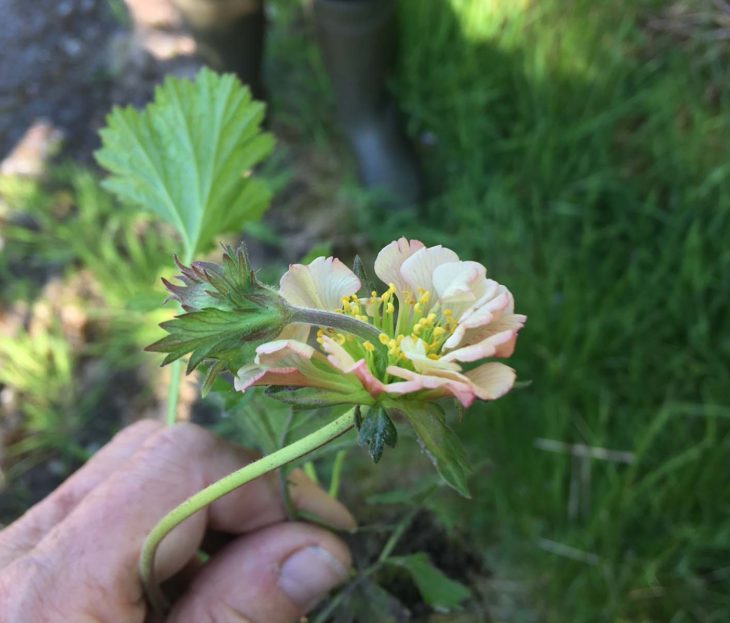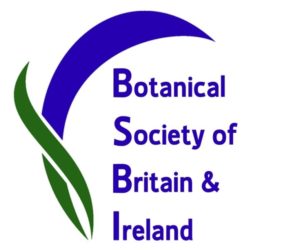Kirkcudbrightshire Botany Group at Auchenreoch Loch 24/05/2018
Just three of us, in brilliant and very warm weather, covered one monad (NX8171) along the lochside very thoroughly and another (NX8271) not so thoroughly, also along the lochside. In the first we got 153 species and in the second 62 species.
But amongst all these there were several outstanding records. Thanks to you both for the help.

We started off in wet alder woodland bordering the noisy and busy A75, where Zoe spotted the yellow-flowered Symphytum tuberosum and then an aberrant Avens, Geum x hybridum with a secondary flower head appearing out of the centre of another lower flower (I’ve seen this only once before, some years ago near the MOD outside Kirkcudbright).
This was followed by a further hybrid, Wood x Water Avens Geum x hybridum, with its yellowish flower hanging in a bell. There’s all sorts of combinations of the two species’ characteristics for a range of hybrids, just to make life complicated!
The woodland was covered with extensive patches of Creeping Jenny Lysimachia nummularia with its bright green circular leaves, compared to the much less common (at least at this site) Yellow Pimpernel L. nemorum with its pointed leaves. Then there were several clumps of Yellow Flag Iris pseudacorus followed by small patches of a bright green-leaved sedge, finally identified at home next day as Bladder Sedge Carex vesicaria, here commoner than the more usual greyish-leaved Bottle Sedge C. rostrata.
The stony-bottomed loch gave us a few aquatics washed ashore, such as the Ivy-leaved Duckweed Lemna trisulca which is not that frequent in VC73; one or two scattered fronds of Common Duckweed L. minor; what I later identified as three separate water-starworts Callitriche spp. – Pedunculate Water-starwort C. brutia, Various-leaved Water-starwort C. platycarpa and, in the second square only, Autumnal Water-starwort C. hermaphroditica. Canadian Pondweed Elodea canadensis was in profusion and there were a few strands of the very fine-leaved Small Pondweed Potamogeton berchtoldii, as well as some strands of Spiked Water-milfoil Myriophyllum spicatum, identifiable by the whorls of leaves being stiff and not collapsing out of water as the other species do. In both squares we had the slightly elongated but oval leaves of the Yellow Water Lily Nuphar lutea, with its veins radiating out from the top of the petiole, and in deep water of the first square the round leaves of White Water Lily Nymphaea alba with its veins in herring-bone fashion. I had also unknowingly collected a stonewort when pulling up the washed-up litter which I think may be Chara vulgaris but this needs confirmation – I’m no expert on this group. And of course Common Spike-rush Eleocharis palustris (mostly chewed by farm stock (mainly sheep) but some with the flowering spike still intact) along with Common Reed Phragmites australis and Reed Canary Grass Phalaris arundinacea.

Violets were scattered but abundant in the woodland, all the usual Common Dog Violet Viola riviniana, with its white/creamy spur, except for one clump which had a violet-blue spur the same colour as the petals.
Being unsure of the species I took some bits home and later identified it as the Early Dog Violet V. reichenbachiana, which in VC73 has only three other known sites, all east of here – one of which we re-found during the first ever meeting of the group in 2014 at Routin Bridge.
Several ancient semi-natural woodland (ASNW) indicator plants were recorded – the above-mentioned Yellow Pimpernel and Wavy Bittercress Cardamine flexuosa recognisable by the six stamens within the four white petals.
Red-berried Elder Sambucus racemosa, an introduced species, occurred in several places, as opposed to the usual Elder S. nigra of which we found only one plant in the second square. The ruins of a small building in the woodland gave us Harts-tongue Fern Asplenium scolopendrium with its undivided blades and the very much smaller pinnate fronds of Maidenhair Spleenwort A. trichomanes subsp. quadrivalens. The whole woodland had a ground carpet of ferns ranging from Male Fern Dryopteris filix-mas through other ferns Dryopteris spp. – Narrow Buckler Fern D. carthusiana, Scaly Male Fern D. affinis agg. and the much finer fronded Female Fern Athyrium filis-femina.
We didn’t have time to get to the far eastern end where I thought there would be some interesting finds in the apparently species-rich marsh – perhaps another time?
As for other things, we had a large and very noisy rookery (93 nests) at the western end; 2 small broods of Canada Geese and one of Mallard in the centre of the loch; and two large Badger setts with major excavations in the form of huge spoil heaps in front of several large D-shaped holes.
David Hawker
BSBI county recorder for Kirkcudbrightshire VC73

